Exmouth
| Exmouth | |
| Devon | |
|---|---|
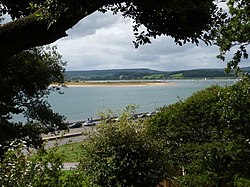 Across the Exe from Exmouth | |
| Location | |
| Grid reference: | SY004809 |
| Location: | 50°37’12"N, 3°24’47"W |
| Data | |
| Population: | 35,939 (2011) |
| Post town: | Exmouth |
| Postcode: | EX8 |
| Dialling code: | 01395 |
| Local Government | |
| Council: | East Devon |
| Parliamentary constituency: |
East Devon |
Exmouth is a port town and seaside resort in Devon, standing on the east bank of the mouth of the River Exe, in the east of the county, as it opens into the English Channel. In 2011, it was recorded with a population of 35,939, making Exmouth the 5th most populous town in Devon.
History
There has long been a port here, at the mouth of a broad, sheltered estuary. Byzantine coins dating back to around 498–518, with the mark of the Emperor Anastasius I, were retrieved on the beach in 1970.[1] In the 11th century, Exmouth Point was referred to by the name Lydwicnaesse; "the point of the Bretons"[2]
Two ecclesiastical parishes, Littleham and Withycombe Raleigh, make up the town of Exmouth today, parishes dating back to Anglo-Saxon times. The name of the River Exe is ancient Celtic, pre-Roman indeed, but the name of Exmouth is more recent.[2]
In 1240 an area known as Pratteshuthe[2][3] (Pratt’s landing place) was sold to the mayor and citizens of Exeter.[2] This was the site of the estuary’s ferry dock and over time the name evolved first into Pratteshide,[2] then Mona Island. The original site is marked by a seating area next to the Magnolia Shopping Centre.[4]
For some centuries, commercial trade through the port was limited in part by the shallow waters on the approach to the quay, but mainly by the power of Exeter, which owned the dock and controlled all estuary traffic.[2] The roads in and out of the area were in a poor state and only occasionally repaired by the parishes through which they ran.[2] A more permanent dock was built in 1825,[2] replacing a series of apparently seasonal docks first noted on maps from 1576 as "The Docke".[2] New docks designed by Eugenius Birch were opened in 1868, and a short line connected them to the railway goods yard.[5] The area adjacent to the docks once housed a thriving community of some 125 chalets built on the shoreline. These have been replaced by a residential marina complex known as Exmouth Quay.
Few homes were built at once, given the harshly exposed position on the estuary, but town building took hold in the more comfortable outer lying rural areas. The town of Exmouth began to develop in the 13th century .[2] Morin Uppehille owned the land, granting part of it to John the Miller who in turn built a windmill, and earned his living on the exposed point, aided by the prevailing south-west winds. The windmill, the ferry dock and a small settlement of farms began to develop into Exmouth.[2]
Sir Walter Raleigh (born 1544) sailed on many of his voyages from Exmouth harbour.
In the mid 17th century the area suffered from the ravages of Turkish pirates[2] (actually Algerian rovers), who raided the Devon and Cornwall coastlines, attacking shipping and attempting to capture sailors and villagers for sale as slaves in North Africa.
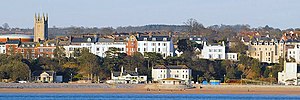
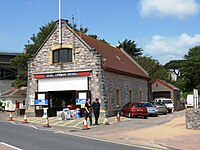
The town truly established itself during the 18th century. Regarded as the oldest holiday resort in Devon, visitors unable to visit Europe due to the revolutionary turmoil in France were attracted by the views and medicinal salt waters which were then very much "the thing".[2] Exmouth was renowned as a destination for the wealthy to recover their health. Notable visitors in this time included Lady Byron, and her daughter Ada Lovelace),[2]. Exmouth was also the residence of Lady Nelson, the estranged wife of Lord Nelson. She is buried in Littleham Churchyard.[2]
Exmouth's first lifeboat was provided in 1803. A boathouse was built near Passage House but was washed away in a storm in 1814. The Royal National Lifeboat Institution revived Exmouth Lifeboat Station in 1858. A new boathouse was built near the beach, although the lifeboat had to be taken across the road before it could be launched. This boathouse was demolished and a one built on the same site in 1903 to accommodate a larger lifeboat. From 1961 the lifeboat was kept afloat in the river near the entrance to Exmouth docks. A boarding boat was kept on a davit that was lowered into the water to ferry the crew to the lifeboat. The old lifeboat station by the beach was retained as a fund-raising display centre and, from 1966, was the base for an inshore lifeboat.[6] The building used by crews at the docks was demolished in 1996 and replaced by temporary portable buildings. On 21 November 2009 both lifeboats were transferred to a new lifeboat station in Queen's Drive at the eastern end of the beach. The old boathouse was retained as a base for the RNLI lifeguards who work in and around Exmouth.[7]
High class tourism remained steady for a number of years. This changed when the first railway line into Exmouth was built in 1861,[8] bringing with it mass tourism. It is from this "golden age" for Exmouth that the present form of the town can be traced.
Churches
Exmouth has a number of active churches. Holy Trinity Church was built by Lord Rolle, at the cost of £13,000 in 1824 to 1825. Standing on Beacon Hill it was built in the perpendicular style with a tower 104 feet high, containing a clock and a bell. The interior, which has 1,500 sittings, has a canopy of Beer stone in the florid Gothic style over the communion table.
Until the erection of Holy Trinity, Exmouth was without a Church of England church, for though a small ancient chapel, dedicated to the Holy Trinity, was standing in 1412, all traces of it disappeared many centuries ago.[9]
- Church of England:
- Holy Trinity
- Christ Church
- Baptist: Exmouth Baptist Church
- Independent evangelical:
- KingsWay
- Ichthus Community Church
- Methodist: Exmouth Methodist Church
- Roman Catholic: Holy Ghost
About the town
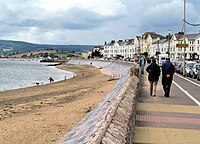
Exmouth thrives on the summer tourist trade. Also it is a regional centre for leisure industries, particularly water sports such as sailing jet-skiing, and wind-surfing, and outdoor activities such as bird-watching, and walking. Exmouth also serves as a commuter town for Exeter, to which it has good public transport links by train and bus.
The town is defined by the sea and river frontages (each about a mile long), and stretches around 2½ miles inland, along a north-easterly axis. The docks lie at the western corner of this rectangle, where the river passes through a narrow passage into the sea, the mouth of the estuary being nearly closed by Dawlish Warren on the opposite shore of the river. Dawlish Warren is a natural sand spit and is home to rare wildlife and plants, part of which is a nature reserve and restricted access. The sea frontage forms a sandy two mile long beach; at its eastern end, the town is limited by the cliffs of the High Land of Orcombe, a National Trust-owned open space which rises to a peak at Orcombe Point.
Geologically, the low hill known as "The Beacon", in the centre of the present town, is formed of breccias that are an outcrop of a similar formation on the west side of the Exe estuary. The rising land on which the town has grown is formed of New Red Sandstone. This solid land is surrounded by mudflats and sandspits, some of which have been stabilised and now form part of the land on which the town is built, and some of which remain as tidal features in the estuary and off the coast. The outflow from the river flows eastwards, parallel to the beach for some distance, limited by sandbanks that are exposed at low tide. Buildings in this reclaimed land during high tide, are often fitted with pumps to pump the water from their basements.
The Exe Estuary is a Site of Special Scientific Interest and is noted in particular for its wading and migrating birds. A large part of the estuary lies within a nature reserve. Exmouth marks the western end of the Jurassic Coast World Heritage Site, which stretches eastwards along the coast to Poole in Dorset. The South West Coast Path allows for walking along this coast. The town is also at the western end of the East Devon Way path that leads to Lyme Regis.
Sights of the town
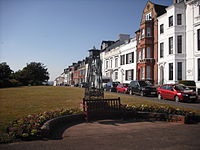
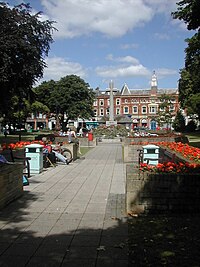
A La Ronde is a 16-sided 18th-century house, now in the ownership of the National Trust. It stands on the northern outskirts of the town.
The Barn at the eastern end of Exmouth is a late 19th century house in Arts and Crafts]] style.
Exmouth Lifeboat Station is at the eastern end of the seafront near Maer Road. From here the Royal National Lifeboat Institution operates a ‘’Mersey’’ All Weather Lifeboat named Margaret Jean and an Inshore Lifeboat named George Bearman.[6]
Architecture
Exmouth has a wide range of architecture, ranging from small cob cottages in parts of the town that were once villages and are now incorporated into it, such as Withycombe, to the Georgian, Victorian and Edwardian town houses. The seafront has a traditional promenade. High above the promenade is the Beacon terrace, which first became the place to be seen in Georgian times.
The majority of buildings in Exmouth were constructed during the Victorian era with the arrival of the railway. The area to the west of Exeter Road is land that was reclaimed by the railway, Exeter Road originally being part of the seafront. Some houses near to the station in Littleham were constructed for the workers on the railway.
Sport
- Cricket: Devon County Cricket Club play their Minor Counties Championship matches at The Maer Ground.
- Football: Exmouth Town FC
- Rugby: East Devon Eagles
Outside links
| ("Wikimedia Commons" has material about Exmouth) |
References
- ↑ Neil Holbrook, Paul T. Bidwell and Lindsay Allason-Jones (1991). Roman finds from Exeter. Exeter City Council. Presses Université Laval. p. 42. ISBN 0-85989-367-7.
- ↑ 2.00 2.01 2.02 2.03 2.04 2.05 2.06 2.07 2.08 2.09 2.10 2.11 2.12 2.13 2.14 The route book of Devon, Publisher Besley, 1870, Publisher: Oxford University
- ↑ Ecclesiastical antiquities in Devon by George Oliver & John Pike Jones, ISBN 0-554-71893-6, ISBN 978-0-554-71893-4
- ↑ History Of Exmouth, Devon. "History Of Exmouth, Devon". Exmouthonline.com. http://www.exmouthonline.com/history.php. Retrieved 2012-02-23.
- ↑ Mitchell, Vic; Smith, Keith (1992). Branch Lines to Exmouth. Midhurst: Middleton Press. ISBN 1-873793-00-6.
- ↑ 6.0 6.1 Leach, Nicholas (2009). Devon's Lifeboat Heritage. Chacewater: Twelveheads Press. pp. 6–9. ISBN 978-0-906294-72-7.
- ↑ Salsbury, Alan (2010). A History of the Exmouth Lifeboats. Wellington, Somerset: Halsgrove. pp. 132–146. ISBN 978-0-85704-073-2.
- ↑ "Illustrated London News 1861". Iln.org.uk. http://www.iln.org.uk/iln_years/year/1861.htm. Retrieved 2012-02-23.
- ↑ EXMOUTH From White's Devonshire Directory of 1850
